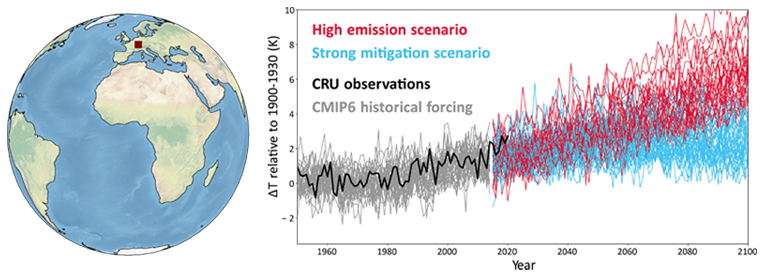New ways to fuse satellite data with climate change projections
We combine satellite data and machine learning  to reduce uncertainties in climate change projections. This is important, because when and if we will cross policy-relevant thresholds (e.g. 2 °C global warming) is still highly uncertain according to ensembles of state-of-the-art climate models, see figure on the right for temperature projections at a location close to KIT/Karlsruhe. Each line corresponds to a climate model temperature projection from the CMIP6 archive for historical (grey) and possible future scenarios (blue, red). Observational data from the Climatic Research Unit (CRU) is shown in black. Reducing the still large inter-model spread in such projections, even for a given future scenario, is a key challenge of modern climate science. Better observational constraints on this uncertainty are needed for better climate risk assessments and to inform society.
to reduce uncertainties in climate change projections. This is important, because when and if we will cross policy-relevant thresholds (e.g. 2 °C global warming) is still highly uncertain according to ensembles of state-of-the-art climate models, see figure on the right for temperature projections at a location close to KIT/Karlsruhe. Each line corresponds to a climate model temperature projection from the CMIP6 archive for historical (grey) and possible future scenarios (blue, red). Observational data from the Climatic Research Unit (CRU) is shown in black. Reducing the still large inter-model spread in such projections, even for a given future scenario, is a key challenge of modern climate science. Better observational constraints on this uncertainty are needed for better climate risk assessments and to inform society.
We develop new ideas for fusing Earth observations (e.g. satellite data) and big data climate modelling archives using machine learning. Ultimately, this allows us to tackle longstanding uncertainties in climate change projections of the troposphere and the stratosphere. In recent publications, we have for example derived better constraints on the feedback effects of changes in Earth's cloud cover and stratospheric humidity on global warming. Changes in clouds are the main uncertainty factor in current global warming projections, whereas changes in stratospheric humidity are important not just for climate change, but also for the future of the ozone layer, which makes life on Earth possible. We found that both mechanisms rather act to amplify global warming, i.e. to lead to even more warming as the world heats up. Our results also implied that the current inter-model spread in projections is not consistent anymore with the now available observational evidence.
We currently run several projects following similarly impactful approaches, for example as part of the ML4CLOUDS project - a collaboration with groups at Imperial College London, the University of East Anglia, the University of Oxford, and UC San Diego.
Selected publications:
Congrats to our postdoctoral researcher Dr Sarah Wilson Kemsley who recently won an early career presentation award at the CFMIP Meeting 2025 in Exeter, UK, for her work on observational constraints!
(1) Wilkinson, Nowack, Joshi. Process-based machine learning observationally constrains future regional warming projections. Journal of Geophysical Research: Machine Learning and Computation (2025).
(2) Nowack & Watson-Parris. Opinion: Why all emergent constraints are wrong but some are useful - a machine learning perspective. Atmospheric Chemistry and Physics (2025)
(3) Wilson Kemsley, Nowack, Ceppi. Climate models underestimate global decreases in high-cloud amount with warming. Geophysical Research Letters (2025).
(4) Ceppi et al. Implications of a pervasive climate model bias for low-cloud feedback. Geophysical Research Letters (2024).
(5) Nowack et al. Response of stratospheric water vapour to warming constrained by satellite observations. Nature Geoscience (2023).
(6) Ceppi & Nowack. Observational evidence that cloud feedback amplifies global warming. PNAS (2021).
(7) Nowack et al. Causal networks for climate model evaluation and constrained projections. Nature Communications (2020).
(8) Thomas et al. An unsupervised learning approach to identifying blocking events: the case of European summer. Weather and Climate Dynamics (2021).
